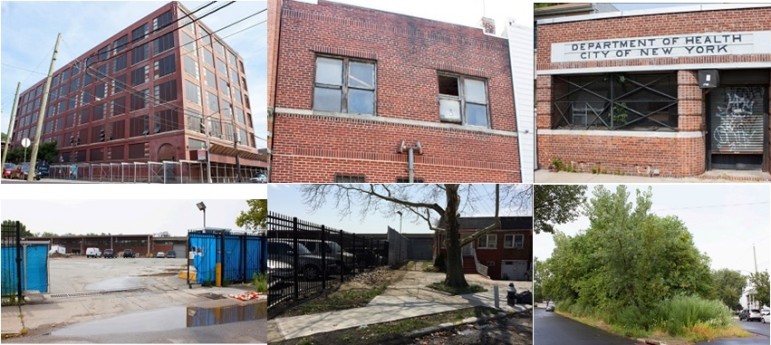
DCAS
Six of the seven parcels auctioned by the city this week.
An otherwise obscure bureaucratic event—the auction of city property—drew protesters to the Bronx on Wednesday. Their argument: that it was wrongheaded for the de Blasio administration to sell off land when the city so desperately needs space to build the 80,000 units of affordable housing the mayor has promised.
Seven parcels were on offer in the October 28 auction at the Bronx County Courthouse, two apiece in the Bronx, Brooklyn and Queens and one in Staten Island. Four are in residential areas and four in manufacturing zones.
“There are buildings that are zoned residential where nobody lives right now that could become people’s homes. There are people that used to provide community services—a former health department building—that could provide those services again,” Paula Segal of the land-use advocacy group 596 Acres said as a small group of demonstrators gathered on the courthouse steps. “But instead they’re being offered to private developers.”
Only five of the parcels sold on Wednesday, fetching prices between $200,000 to $11 million. The Department of Citywide Services, which oversaw the auction, was not able to identify buyers by press time.
New York City has been in the business of subsidizing the creation of privately owner affordable housing for 30 years. But the primary difference between the Koch administration’s housing initiative and the later efforts by mayors Bloomberg and de Blasio is that Mayor Koch had plenty of land to play with—hundreds of parcels that the city had come to own as New York’s population shrunk during the 1970s.
As the stock of city-owned land dwindled, the task of building new housing became much harder for recent mayors. Nowadays, land costs drive up the cost of creating affordable housing, which it turn makes it difficult to set rents that serve families most in need of housing help. Groups like Picture the Homeless, which joined Wednesday’s protest, have long advocated that the city should capitalize on vacant properties as a housing resource.
Asked about the auction, DCAS told City Limits in a statement: “Mayor Bill de Blasio recently announced that the city financed the creation and preservation of 20,325 affordable apartments and homes during fiscal year 2015, enough housing for more than 50,000 New Yorkers and the most in 25 years.” The agency noted that one of the auctioned buildings, which is zoned for industrial use, had been purchased by a company that would preserve all 28 jobs now at the site.
As to the residential properties, DCAS said it circulated the list of parcels to all city agencies before the auction, and only included those for which no department claimed a use.
The Department of Housing Preservation and Development, which is orchestrating the mayor’s housing plan, says it looked all the parcels over and determined that none were suited for affordable housing. Two of the lots are mere slivers, two are in industrial zones and the rest are too small to permit cost-effective affordable housing, the agency says.
“It is not in anyone’s best interest for us to take on a parcel that, for any combination of reasons, cannot be developed,” a spokesperson for the agency emailed. “It is our belief that these lots are better suited for public auction so that a clear and productive use can be found.”
But Anna Burnham, a community organizer at the neighborhood improvement organization Banana Kelly, thinks the de Blasio administration needs to think more creatively.
“It is shortsighted for the city to auction land and claim that its zoning restriction is reason enough as to why it can’t be used as housing,” especially given that the administration is pursuing a controversial rezoning along Jerome Avenue in the Bronx, she said. “Selling these buildings now means that they will never get them back and they surrender any opportunity to utilize these parcels.”
Burnham concedes that not all the parcels offered Wednesday could host housing, but she contends that neighborhoods could come up with creative ways to use that land to support equitable development, like controlling the parcels through a community land trust where commercial rent or industrial leases are used to subsidize low-income residences. “They should be put into community control,” she said of the properties. “The people in these neighborhoods know what they need and history shows they’ll come up with creative solutions to meet those needs, with or without city support.”
City Limits’ coverage of housing policy is supported by
the Charles H. Revson Foundation.









One thought on “Protest as City Auctions Land Despite Housing Need”
Most of the city-owned lots are odd-shaped parcels. The one S.I. parcel (no takers) is 7309 sq.ft. of vacant land zoned R3X which only permits 1 or 2 family homes. I’m surprised no one bought it, builders usually snap up a parcel like that one.